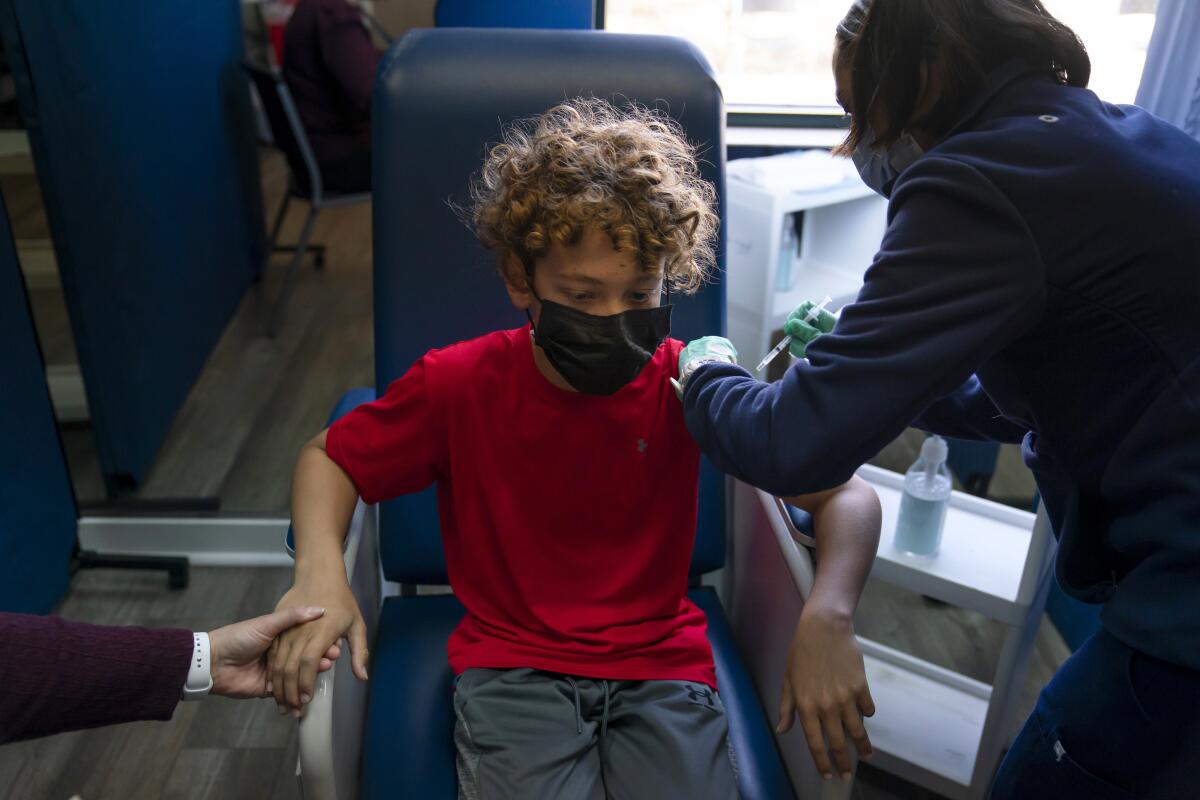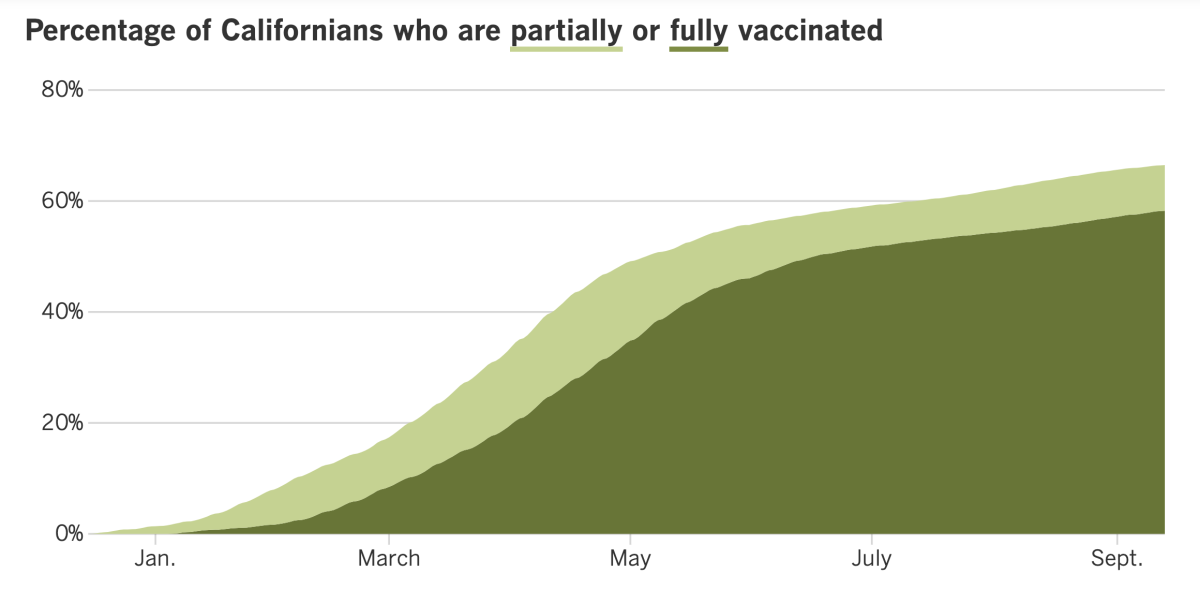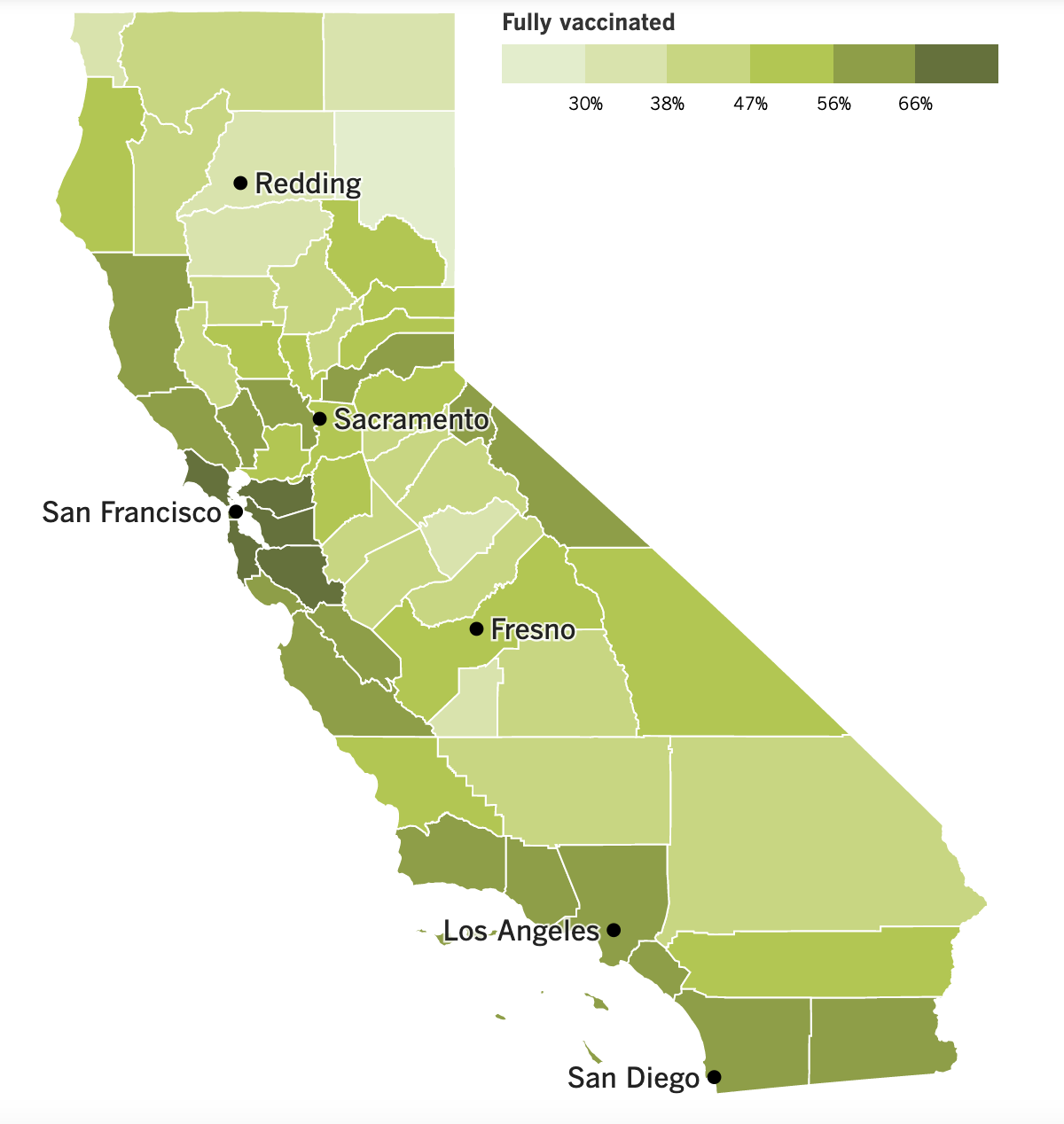Coronavirus Today: Pediatricians vs. the FDA
- Share via
Good evening. I’m Karen Kaplan, and it’s Tuesday, Sept. 14. Here’s the latest on what’s happening with the coronavirus in California and beyond.
With so much attention focused on the 80 million vaccine-eligible Americans who have yet to roll up their sleeves, it’s easy to forget there are millions more who would get the shot in an instant if only the U.S. Food and Drug Administration allowed it.
They are among the roughly 48 million American children ages 11 and younger who are not old enough for an authorized vaccine. Some of these kids are eager to get the same protection as their older siblings. Others may feel ambivalent themselves, but their anxious parents will sign them up for an appointment at the earliest opportunity.
One group that’s impatient to extend the benefits of COVID-19 vaccines to younger children is the American Academy of Pediatrics. In fact, this group of doctors has been lobbying the FDA to hurry up and authorize a vaccine for younger children already.
Yes, the AAP says, regulators should gather all the relevant data from clinical trials of children in the target age group. Yes, it says, regulators should take care to search for signals that the vaccine may cause serious side effects in even a small sliver of kids.
But the idea that children can afford to wait indefinitely because they face little risk from the coronavirus went out the window with the ascent of the Delta variant. Indeed, the rate at which children were hospitalized with COVID-19 has multiplied almost fivefold over the course of the summer.
“The Delta variant has created a new and pressing risk to children and adolescents across this country,” the academy wrote in an Aug. 5 letter to the FDA. The doctors exhorted the agency “to carefully consider the impact of its regulatory decisions on further delays in the availability of vaccines for this age group.”

Vetting the vaccine for young children is more complicated than it was for adolescents. The Pfizer-BioNTech vaccine was tested in 16- and 17-year-olds during the initial clinical trials for adults, and 12- to 15-year-olds tested the same regimen.
But the trials for younger kids don’t simply follow the same template — because young children aren’t simply little adults. Their immune systems work differently. They metabolize medicines and vaccines differently. Their muscles and organs function differently. All of that means the ideal vaccine formulation, dosage and time between shots might be different, the FDA warned.
On top of that, the FDA is also concerned about the emergence of rare side effects, including a swelling or inflammation of the heart muscle known as myocarditis. The condition was seen primarily in boys and men younger than 30 who had recently been vaccinated, though it’s not clear whether the vaccines were responsible. (Thankfully, the symptoms were generally mild and resolved in a few days.)
To get a better sense of the prevalence of this possible side effect, the FDA asked vaccine makers to increase the number of children in their trials and to track them for longer. Pfizer and Moderna complied.
Even if a serious side effect occurred in only 1 child out of 1 million, it could result in the hospitalizations or deaths of up to 120 children in the U.S., said Dr. Paul Offit, a vaccine expert at Children’s Hospital of Philadelphia. That’s why it’s important to look for them.
But waiting to vaccinate younger kids has costs too. “It’s frustrating that children are back in school and that they’re not vaccinated,” Offit said.
Scientists at the FDA — many of them parents and grandparents — are frustrated as well. In an unusual public statement, acting Commissioner Dr. Janet Woodcock and Dr. Peter Marks, director of the FDA’s Center for Biologics Evaluation and Research, said they’re longing for the day when a vaccine for the under-12 set receives emergency use authorization. But they won’t rush it.
“Just like every vaccine decision we’ve made during this pandemic,” they said, “our evaluation of data on the use of COVID-19 vaccines in children will not cut any corners.”
By the numbers
California cases and deaths as of 4:08 p.m. Tuesday:

Track California’s coronavirus spread and vaccination efforts — including the latest numbers and how they break down — with our graphics.
Another way we’re holding ourselves back
The effort to bring the pandemic under control requires action on many levels. There are tools like vaccines and masks to reduce the risk of becoming infected in the first place. When infections do occur, we do our best to isolate people so they don’t spread the virus to others. And to keep an outbreak from spiraling out of control, we rely on contact tracers to identify those who were exposed to an infected person so they can be tested too — then quarantined or isolated if necessary.
It’s no secret that we could be doing a lot better when it comes to getting people vaccinated. Our testing system is straining under the demand imposed by the Delta variant. Now my colleague Emily Alpert Reyes reports that we’re shooting ourselves in the foot when it comes to contact tracing too.
The contact tracing system in Los Angeles County has faced challenges all along. Notably, contact tracers had trouble detecting and containing outbreaks in workplaces like the Farmer John pork processing plant in Vernon, SoFi Stadium in Inglewood and a Los Angeles Apparel garment factory in South L.A.
Last summer, contract tracers were able to interview up to 70% of the infected people they were assigned to track down each week. That may not sound great, but consider this: Only 40% of the people on contract tracers’ lists were reached during the final week of August.

It’s not always for lack of trying. With vaccination rates for people ages 50 to 64 approaching 84% in in L.A. County and 75% for senior citizens, younger residents are making up a larger share of new infections — and they may be less willing to answer a call from an unfamiliar phone number, health officials say. Calling back repeatedly and leaving messages hasn’t helped.
Contract tracers have tried to adapt by texting people instead. In some cases, the strategy has backfired.
“They call us back and tell us, ‘Take me off your list and stop texting me,’” said Gema Morales-Meyer, who directed the health department’s case and contact interview branch until earlier this summer.
Contact tracers didn’t fare much better when they reached out to people face-to-face. Knocking on doors is a lot more time-consuming, but they hoped the extra effort would be worth it.
Instead, they’ve been getting less-than-warm welcomes.
One woman who opened the door to Vishia Tolcidas told her: “It’s so inappropriate. You’re coming to the homes uninvited.”
“I said, ‘I’m just coming in to provide help,’” said Tolcidas, who became a contact tracer a few months ago. The woman replied, “I don’t need your help.”
Contact tracers suspect they get the brush-off because infected people don’t want to own up to the fact that they’ve been mingling with others. Some may fear that their family, friends and acquaintances will be angry when they learn they’ve been put at risk.
A general sense of “COVID fatigue” is likely another factor. In the pandemic’s early days, there was an all-hands-on-deck mentality to pull together against the coronavirus.
Now, not so much.
California’s vaccination progress


See the latest on California’s vaccination progress with our tracker.
Consider subscribing to the Los Angeles Times
Your support helps us deliver the news that matters most. Become a subscriber.
In other news ....
As pressure mounts to move more unvaccinated people into the vaccinated column, resistance to vaccine mandates is growing.
Six members of the Los Angeles Police Department filed a lawsuit in federal court Saturday claiming that the city’s vaccine mandate violates their constitutional rights to privacy and due process.
They say they “can safely perform their job duties protecting themselves, fellow employees and the community they serve through non-pharmaceutical interventions such as daily health screenings, wearing masks, and quarantine.” They also argue that people who have developed coronavirus antibodies from a bout with COVID-19 shouldn’t need to get a shot.
Riverside County Sheriff Chad Bianco made a similar argument when he vowed not to enforce any vaccine mandates for employees of his department. Speaking on the department’s podcast Monday, he said that so-called natural immunity provides “far more” protection against COVID-19 than the vaccines. (Bianco had COVID-19 earlier this year.)
U.S. public health leaders disagree. They have consistently advised people to get vaccinated even if they’ve had COVID-19 on the grounds that the immunity provided by the vaccine is more predictable — and typically stronger — than the immunity that results from an infection. For instance, a report published last month by the Centers for Disease Control and Prevention found that unvaccinated people were more than twice as likely to get a repeat coronavirus infection than their vaccinated peers.
In San Diego County, thousands of healthcare workers have sought exemptions to the vaccine mandate for healthcare workers that President Biden announced on Aug. 5. A number of the requests came from people who said they want to decide for themselves what to put in their bodies. But most said they opposed COVID-19 vaccines on religious grounds, with requests typically citing the involvement of fetal cells.
The Johnson & Johnson vaccine is produced with the help of a cell line derived from retinal tissue obtained from an abortion in 1985, though the cells are not an ingredient in the vaccine itself. The vaccines made by Pfizer-BioNTech and Moderna were developed and tested using another cell line grown from kidney cells obtained from an abortion in 1973; those cells aren’t in the vaccines either.
It’s unclear whether concern about fetal cells will be enough to earn a religious exemption to vaccine mandates, especially since multiple religious authorities — including Pope Francis — have called the vaccines morally acceptable and encouraged people to get them.
Republican leaders across the country have threatened lawsuits and acts of civil disobedience to prevent Biden from implementing the sweeping vaccine mandate he announced last week. South Carolina Gov. Henry McMaster, for example, vowed to fight “to the gates of hell to protect the liberty and livelihood” of his constituents.
A majority of Americans support vaccine mandates, especially for healthcare workers, teachers, people whose jobs require them to interact with members of the public, and members of the military, according to a poll last month from the Associated Press-NORC Center for Public Affairs Research.
With support like that, Biden isn’t backing down. Asked about threats to take his vaccine mandate to court, he dared his opponents to “have at it” and accused them of “actively working to undermine the fight against COVID-19.”
The country undeniably has a long way to go to get the pandemic under control. Data from the CDC show that all but three states still have “high” coronavirus transmission levels, with at least 100 new coronavirus cases per 100,000 people in the past week.
But California isn’t one of them. The Golden State has joined Connecticut and Vermont — as well as the District of Columbia and Puerto Rico — in the category of “substantial” transmission, a tier for places with 50 to 99.99 new cases per 100,000 people over the last week. The CDC pegs California at 97.8 as of Tuesday evening.
State health officials touted California’s progress. Dr. Erica Pan, the state epidemiologist, tweeted that “CA is one of the few states and the only large state to improve from red to orange COVID-19 Community levels of transmission.” The state’s relatively high vaccination rate — 66.5% of Californians are at least partially vaccinated and 58.2% are fully vaccinated — and indoor mask policies in counties where a majority of Californians live helped make the move possible, she said.
Meanwhile, the debate over the need for COVID-19 booster shots is heating up. An advisory committee for the Food and Drug Administration is set to meet Friday to consider whether vaccine immunity has waned enough among the earliest recipients to warrant giving a third dose.
Biden said last month that his administration planned to begin offering the shots the week of Sept. 20, but some critics said he was moving faster than science. That includes two top vaccine reviewers at the FDA who recently announced that they were stepping down from their positions.
The pair, Drs. Phil Krause and Marion Gruber, joined 16 other researchers from around the world in writing a commentary in the medical journal Lancet. The authors cited studies of the vaccines’ performance and concluded that the shots are still working despite the rise of Delta.
“Even in populations with fairly high vaccination rates, the unvaccinated are still the major drivers of transmission” at this stage of the pandemic, they wrote. They added that it would be better to develop boosters that specifically target Delta and other coronavirus variants in wide circulation.
And finally, Russian President Vladimir Putin has quarantined himself after members of his inner circle tested positive for coronavirus infections.
Putin, who has taken the Sputnik V vaccine, has tested negative for an infection himself. He attended several public events Monday, and images shown on TV indicated that masks were not worn.
Kremlin spokesman Dmitry Peskov said that Putin is “absolutely healthy” and insisted that “no one’s health was endangered” at Monday’s events.
Your questions answered
Today’s question comes from readers who want to know: Where can I get help now that temporary programs for unemployed Americans have ended?
It’s been 10 days since time ran out on four federal programs aimed at helping unemployed and underemployed people weather the pandemic. A 13- to 20-week extension of unemployment benefits also sunsetted on Saturday.
But help is still available for financially struggling Californians. My colleague Jon Healey summarizes it for you.
Jobs: The state’s CalJOBS site can match you with an employer, and the state’s Employment Development Department offers several other resources to help you find work or change careers.
Food: CalFresh, the food aid program, is offering low-income households 15% more in benefits through Sept. 30. Work requirements for college students have been eased dramatically (for now) so that more young adults can qualify.
Rent: California offers to pay 100% of the rent debt accumulated since April 2020 by low- and moderate-income residents who suffered pandemic-related financial hardship. The program can also pay up to three months of future rent and up to 12 months of unpaid utility bills. Call (833) 430-2122 to apply or visit the Housing Is Key site.
Healthcare: Idled workers whose incomes aren’t low enough to qualify for Medi-Cal can get extra premium support with Covered California that can bring the cost of health insurance down to $1 per person per month. Apply at the Covered California site or by calling (800) 300-1506. Those who were enrolled before they lost their jobs may qualify for lower premiums.
Stimulus checks: The state is sending out Golden State Stimulus checks worth between $600 and $1,100 to Californians who earned up to $75,000 in 2020. To qualify, you have to have filed state tax returns for 2020 — and if you haven’t done it yet, you have until Oct. 15 to do so and still qualify for the stimulus. To find out if you are eligible and to estimate how much you can receive, go to the Franchise Tax Board’s Golden State Stimulus II site.
We want to hear from you. Email us your coronavirus questions, and we’ll do our best to answer them. Wondering if your question’s already been answered? Check out our archive here.
Resources
Need a vaccine? Keep in mind that supplies are limited, and getting one can be a challenge. Sign up for email updates, check your eligibility and, if you’re eligible, make an appointment where you live: City of Los Angeles | Los Angeles County | Kern County | Orange County | Riverside County | San Bernardino County | San Diego County | San Luis Obispo County | Santa Barbara County | Ventura County
Practice social distancing using these tips, and wear a mask or two.
Watch for symptoms such as fever, cough, shortness of breath, chills, shaking with chills, muscle pain, headache, sore throat and loss of taste or smell. Here’s what to look for and when.
Need to get tested? Here’s where you can in L.A. County and around California.
Americans are hurting in many ways. We have advice for helping kids cope, resources for people experiencing domestic abuse and a newsletter to help you make ends meet.
We’ve answered hundreds of readers’ questions. Explore them in our archive here.
For our most up-to-date coverage, visit our homepage and our Health section, get our breaking news alerts, and follow us on Twitter and Instagram.




